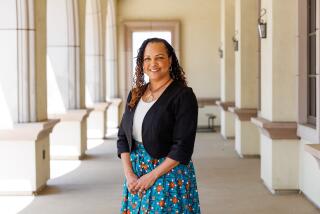Teacher, Blind Students Make Miracles Happen
- Share via
For a final exam of sorts last school year, Diane Fazzi sent one of her Temple City students to ride a bus across town by himself. Fazzi followed in a car, watching to make sure everything went OK.
When the student arrived at his destination, “he got off at the bus stop, and he couldn’t stop smiling,” she said. “Neither could I.”
Fazzi is an orientation and mobility instructor, one of about 70 in the Southland. She and her colleagues help and teach blind and visually impaired students, from elementary to high school, how to live in a society that often does not accept, and sometimes does not understand, their disabilities.
“It’s all working on independence,” Fazzi said. “We want to make it so that they have the advantage of every opportunity (that) everyone else does.”
Fazzi, 26, who has the master’s degree in rehabilitation and mobility orientation that her profession requires, is enthusiastic about her work. After reading “The Miracle Worker,” the story of Helen Keller, in fourth grade, she decided on her career.
Fazzi works for Los Angeles County, which provides specialized instructors to area school districts, such as Temple City Unified. A consortium of 15 districts in the western San Gabriel Valley share her services, Assistant Supt. Richard Anthony said. She spends most days working individually with students in two-hour sessions.
But Fazzi and her fellow mobility instructors offer more than their name implies, her students and co-workers say.
“She’s my best friend,” said a beaming Sophornia Ko, 16, a blind Temple City High School junior. “Mobility is not just how to walk. She teaches me other things too--how to put makeup on and things like that.”
Three days a week during the school year, Ko works with Fazzi, learning and practicing skills such as crossing streets, maneuvering around campus, counting and identifying money and visiting shopping centers. This spring, it took Ko about a month before she was comfortable making her way across an intersection alone.
“The first time, I was very nervous,” said Ko, who wastes no time demonstrating her bubbly and honest personality. “After I did it more and more, I started doing it pretty well.”
Fazzi and her students get a variety of responses from people on the street, ranging from total ignorance to overeager help. Some, for instance, simply grab blind students and prepare to pull them across a street.
“They just have this feeling that this poor blind person will get hit by a car,” Fazzi said. “They don’t realize they are making things worse. The proper thing is to ask ‘Would you like assistance?’ ”
Sighted students can also make things difficult.
“When you go through the hallway, people stand there and they can’t see who you really are,” Ko said. “They want to know why you bump them with the cane. There’s so many kids (who) don’t accept blind people at all.”
Fazzi emphasizes to her students that they are serving as teachers, in effect, whenever they are interacting with the public. She invites parents to join their children so they can see their child’s accomplishments.
“A lot of times their parents are afraid the same way our parents were scared when we were 15 years old and wanted to get our driver’s license,” Fazzi said. “They couldn’t, or wouldn’t teach us, and said, ‘Go to a professional.’ We should show them what we do.”
Ko said her parents now “trust me and believe in me that I can go on my own,” even in their apartment complex, which encircles an unfenced pool. And Fazzi has been an inspiration to Ko, who wants to be a counselor for the blind after she graduates from Pasadena City College. Ko says she wants to help people who had, but then lost their sight and “don’t know how to handle it.”
“I don’t care how much I earn,” she said.
Fazzi agrees with her priorities.
“It’s not every teacher a student will trust their life to,” she said. “But obviously, when they’re truly independent, I’m not going to be walking behind them.”
More to Read
Sign up for Essential California
The most important California stories and recommendations in your inbox every morning.
You may occasionally receive promotional content from the Los Angeles Times.













